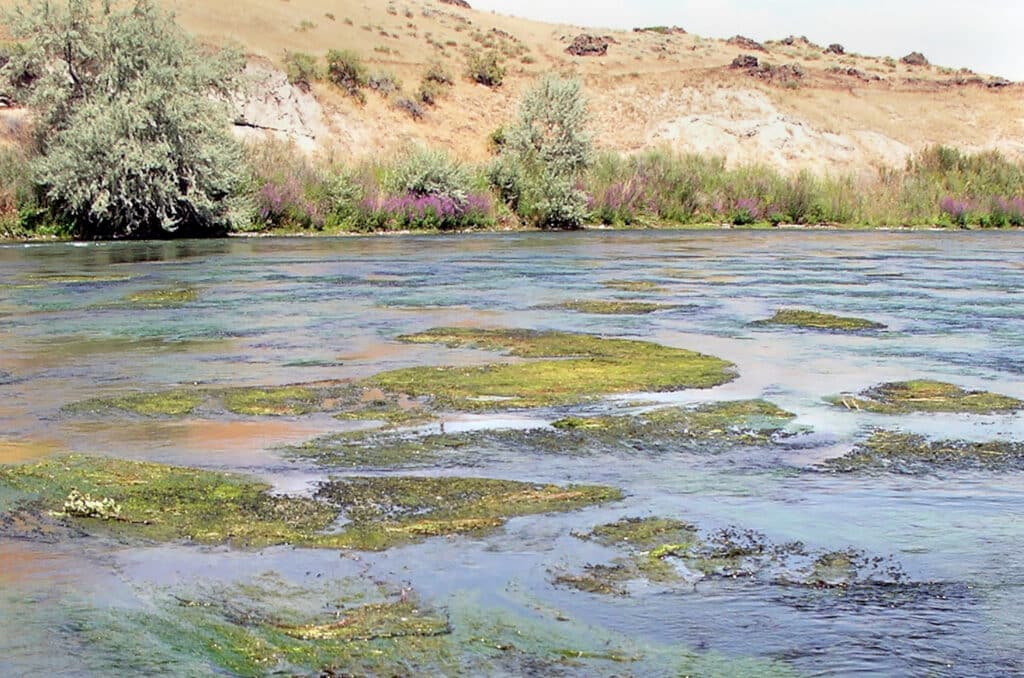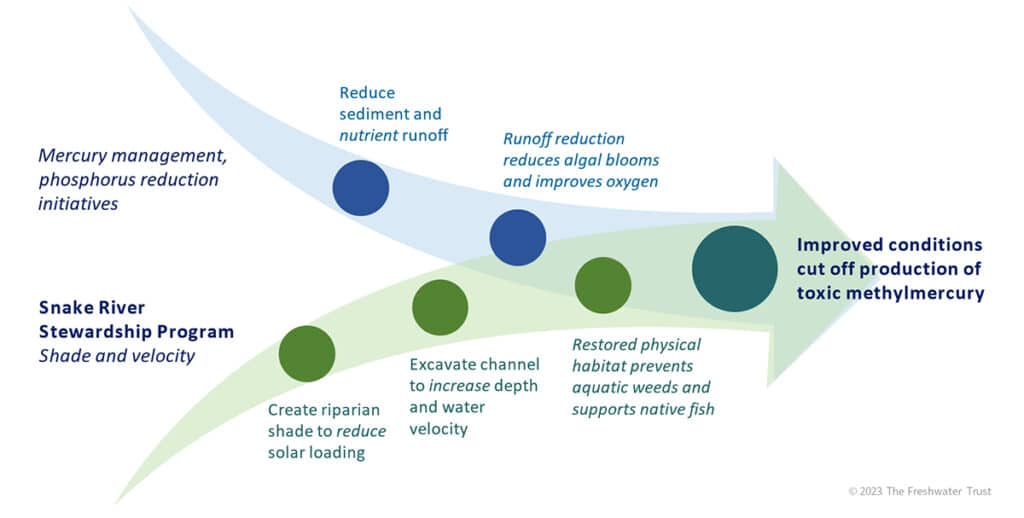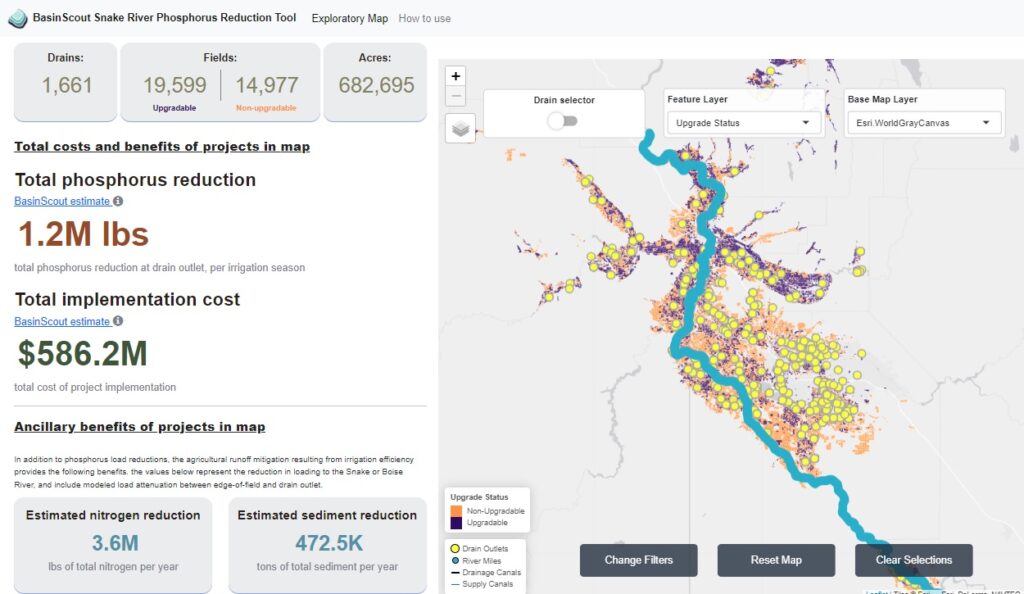A Coordinated Funding Approach to Reduce Toxic Pollution in the Snake River Watershed
October 9, 2023
The Snake River flows into the Columbia, the largest North American river entering the Pacific Ocean. Over 1,000 miles, the river works hard for the West. It is used to generate power for more than 500,000 customers; it supports vibrant tribal and agricultural communities and major regional fisheries; it is enjoyed by recreationists; and it is a major vein for commerce throughout the region.
Yet the Snake River is in trouble. As a result of heavy use, the flow and water velocities of the Snake have decreased, leaving much of the river slow and shallow. Streamside vegetation that would have shaded and cooled the river is gone in many places. And agricultural runoff in the region results in significant sediment, nitrogen, phosphorus, and mercury loads. These conditions are stretching the limits of this critical river.

In the middle reaches of the Snake River, between the CJ Strike and Brownlee Reservoirs, the water is shallow and full of silt and unwanted aquatic plants.
One major issue in the Snake River is high water temperatures. To address this issue, we must restore riparian forest vegetation to reduce the amount of the waterway exposed to direct sunlight. We must also reengineer parts of the river to better fit its floodplain so that the river is deeper and narrower (reducing surface area for sunlight to enter). The Freshwater Trust (TFT) worked closely with Idaho Power Company (IPC) to design and secure regulatory approval for a $350-million watershed restoration solution called the Snake River Stewardship Program (SRSP). The SRSP will fund riparian revegetation upstream of the Hells Canyon Complex of hydroelectric dams and dozens of river reengineering projects in the Mid-Snake River. IPC has committed to the SRSP as a condition for continuing to operate its dams for the next 40–50 years. This program is expected to significantly improve temperature conditions in the Mid-Snake.
With a response to the Snake’s temperature challenge now well underway, TFT and partners are now focused on another major water challenge in the region: toxic methylmercury.
While levels of inorganic mercury in the Mid-Snake River watershed are similar to other regions, considerable amounts of methylmercury are being produced in the river system compared to other rivers in the West. This is driven by several factors. First, the sediment from agricultural runoff makes the river shallower, and the excess phosphorus attached to that sediment runoff fuels algal blooms and aquatic plant growth. This growth is exacerbated by the extra heat loading into the shallow and unshaded river. As aquatic plants die and decompose, the water is depleted of oxygen. The low-oxygen or “anoxic” conditions enable inorganic mercury to be converted into methylmercury, which is the most dangerous form of mercury.
Methylmercury is easily absorbed by fish, can accumulate in the food chain, and can lead to brain disorders and heart disease in humans who consume the contaminated fish. Accumulation of mercury in fish tissue has forced downstream tribes to recommend that members stop eating culturally significant white sturgeon.

Improving the health of the Snake River includes multiple coordinated actions to achieve reductions in water temperature and pollutant loading.
One way to significantly break the cycle of methylmercury production is to work with agricultural producers to convert agricultural fields from gravity-flow flood irrigation to pressurized sprinkler or drip irrigation. This upgrade reduces runoff and erosion from farm fields, which reduces both the load of available inorganic mercury and disrupts the methylation process fueled by excess phosphorus. Additionally, this irrigation approach can help farmers improve their operations and minimize greenhouse gas production (USDA just added irrigation practice codes to the “Climate Smart” Practice List for FY24).
Widespread irrigation upgrades could significantly improve the methylmercury situation in the Snake. Upgrading is often a good decision for farmers. But installing pumps and pipes can be expensive, and taking on debt to make the change can be daunting. While many conservation funding programs could provide the subsidy these farmers need to opt in, funds are trapped in multiple siloed, uncoordinated, and complex programs that don’t arrive in the right amounts or at the right times for farmers.
Furthermore, each potentially available funder focuses on a different “benefit stream” even though all funders could co-fund the same projects. For example, U.S. Environmental Protection Agency (EPA) is focused on reducing toxics in this region, USDA’s Natural Resources Conservation Service (NRCS) supports farmers and ranchers addressing natural resource concerns, Idaho’s Total Maximum Daily Loads (TMDLs) require utilities to reduce phosphorus loads, and Congress wants new Inflation Reduction Act dollars to fund agricultural practices that reduce greenhouse gas (GHG) emissions. Irrigation upgrades produce all those quantifiable benefits, but in practice, each program is difficult to access on its own, let alone in a coordinated fashion.
As a result of these funding complexities, too few projects make it to the starting line, and fewer still make it across the finish line. Farmers and partners need a buffer from the friction, risk, and uncertainty in the conservation funding system or they won’t participate. And siloed and mis-timed funding streams need to be combined or else we’ll keep attacking this big problem project-by-project at a rate that will never add up.
It is currently no one’s job to solve this. What’s required is an aggregator with a watershed-wide perspective who can:
- consolidate otherwise siloed funds,
- leverage that funding into new funding and financing,
- use analytics to target the best projects,
- deliver the right amount of funds on the right timelines to farmers,
- and manage funder reimbursement and benefit reporting.
With this approach operational, we can make the big project push needed to disrupt the methylmercury production cycle.
Through a $5.6 million Toxics Reduction Lead grant from the EPA, TFT is stepping into this role over the next five years in the Snake. Using our precision analytics, TFT and the many funders who have agreed to join this effort will be able to coordinate and target investment to specific projects that can produce reductions cost-effectively. TFT has identified more than 300,000 acres of agricultural land currently using flood irrigation in the Mid-Snake that could be upgraded. Preliminary investigations show that upgrading irrigation on all flood irrigated fields could reduce annual phosphorus loads by 1.2 million pounds for a price of $586.2 million ($488/lb.). The analytics also highlight that 75% of the best runoff reductions could be secured for 31% of the total cost, or $181.7 million ($202/lb.).

Analysis of agricultural fields in the Mid-Snake River basin indicates that 1.2 million pounds of phosphorus reductions are available through feasible irrigation system upgrades. The most cost-effective and impactful reductions (71%) could be achieved with a budget of $182 million.
In addition to having this analytical insight to help guide investment, coordinating the funds will create more opportunities for securing additional funding. TFT and partners will use the coordinated funding to secure even more federal funding during the remaining years of the Inflation Reduction Act (IRA) and Bipartisan Infrastructure Law (BIL).
Specifically, by 2024, we plan to consolidate approximately $9 million in funding commitments to use as “match” to secure up to $25 million in “climate smart” IRA funds from USDA’s Regional Conservation Partnership Program (RCPP). The funding commitments can also help secure a loan that delivers project funds upfront when they are needed, not on annual grant cycles. We plan to repeat this leveraged funding cycle to expand the funding stack. At the same time, TFT will be working with IPC to develop a mercury compliance program that could add tens of millions of non-federal funds to the effort. Through this process, we aim to build a $150–200 million funding pool over the next few years that can then be rapidly deployed to priority projects.
This consolidation and leverage approach will help get compelling funding offers to farmers for high-impact irrigation-conversion projects at the right time. This approach will help unlock rapid and widespread irrigation efficiency adoption by:
- buffering farmers from the misaligned timelines, eligibilities, and needs of the various funds,
- delivering those funds to farmers in simple ways that make sense for their business, and
- supporting local groups and stakeholders with better information and more funding certainty.
TFT is excited to get to work with partners on this critical challenge. We hope this coordinated approach generates momentum, defrays risk, and attracts both political support and more funding.
Top photo: Macrophyte growth, middle Snake River, Idaho, by Idaho Water Science Center. Usage: public domain.
#conservation finance #Idaho #mercury #policy #Snake River #watershed outcomes bank
